나노물질








차세대 작동 유체로서 나노 유체는 지난 30년 동안 오랫동안 뜨거운 연구 주제로 여겨져 왔습니다. 많은 검토 논문에서 나노유체의 개발 및 최신 기술에 대한 포괄적이고 체계적인 요약을 제공했습니다. 오늘날, 방대한 관련 문헌으로 인해 모든 종류의 나노유체에 대한 포괄적인 검토를 제공하는 것이 점점 더 어려워지고 있습니다. 그리고 보고된 주장에서 많은 논쟁과 불일치가 다양한 나노유체에서 관찰되었습니다. 한편, 특정 종류의 나노유체에 대한 체계적이고 종합적인 검토는 부족한 실정이다. 따라서 이 리뷰는 가장 인기 있는 종류 중 하나에 대한 연구에 중점을 둡니다. TiO2 나노유체는 감각적인 분산성, 화학적 안정성 및 무독성과 같은 흥미롭고 포괄적인 특성으로 인해 과학자들의 큰 관심을 끌었습니다. 나노유체의 준비는 전제 조건이고 물리적 특성은 추가 응용을 위한 중요한 요소이기 때문에 검토의 첫 번째 부분은 TiO2의 준비, 안정성 및 물리적 특성에 대한 최근 연구를 요약합니다. 나노유체.
액체의 열전달 능력은 일반적으로 고체 금속이나 금속 화합물의 열전달 능력보다 훨씬 낮기 때문에 액체에 고체 입자를 부유시켜 액체의 열전달을 향상시킬 수 있을 것으로 예상됩니다. 그러나 밀리미터 또는 마이크로미터 입자의 현탁액에서는 분산성, 응집 및 침전이 불량하고 시스템 내부 표면에 부착되어 열전달 성능이 저하되고 펌핑력이 증가하는 등 몇 가지 단점이 나타났습니다. 그리고 심지어 파이프 블록. 이러한 단점을 극복할 수 있는 새로운 기회는 서스펜션 즉, 차세대 서스펜션에서 발견되었습니다. 나노유체는 1995년 Choi에 의해 제안되었다[1].
Nanofluid는 적어도 1차원 크기가 100nm 미만인 나노 입자를 포함하는 새로운 종류의 희석 현탁액입니다. 현탁액의 입자 크기가 나노미터 수준에 도달하면 현탁액이 밀리미터 또는 마이크로미터 입자/액체 혼합물보다 더 나은 열 특성을 달성하고 동시에 더 안정적으로 유지할 수 있을 것으로 예상됩니다. 안정한 나노유체는 또한 더 나은 유동성을 얻을 수 있으며 때로는 단일상 유체로 취급될 수 있습니다. 따라서 나노 유체가 직면한 가장 큰 과제 중 하나는 우수한 열물리적 특성과 추가 엔지니어링 응용을 달성하기 위한 주요 전제 조건인 준비 및 안정성입니다. 따라서 나노유체에 대한 연구는 일반적으로 조제 및 안정성 연구[2,3], 열전도율과 같은 물성[4,5,6,7,8], 점도분석[9,10]의 방향으로 분류할 수 있다. ,11,12], 열전달 연구[13, 14], 엔지니어링 응용[15,16,17,18], 이론 해석 또는 모델 개발[19,20,21,22,23,24,25].
지난 20년, 특히 최근 10년 동안 나노유체에 대한 연구는 그 매혹적인 특성으로 인해 폭발적으로 증가했으며 많은 연구자들이 나노유체의 다양한 측면에 대한 실험적 또는 이론적 연구를 수행했습니다[26,27,28,29]. 이를 설명하기 위해 “web of science”에서 검색된 제목에 “nanofluids or nanofluid”를 포함하는 출판물의 증가 추세를 그림 1에서 확인할 수 있습니다. 이 그림은 나노유체에 대한 연구가 너무 빠르게 성장하고 있음을 분명히 보여줍니다. 2016년 출판물은 지난 20년 동안 전체의 21.9%를 차지했습니다. 검색 범위가 전체 텍스트로 완화되고 더 많은 검색 데이터베이스를 포함하는 경우 결과가 몇 배 증가할 수 있습니다. 따라서 방대한 양의 관련 문헌으로 인해 모든 종류의 나노유체에 대한 포괄적인 검토를 제공하기가 점점 더 어려워지고 있습니다. 그리고 지난 2년 동안 좀 더 포괄적인 리뷰를 제공하기 위해 몇 가지 리뷰가 속성의 한 측면이나 특정 종류의 나노유체에 초점을 맞추었습니다. 예를 들어, 표 1은 다음과 같은 나노유체의 일부 특수 측면에 대한 최신 리뷰를 보여줍니다.
준비 또는 특성화 [30,31,32]
<리> (2)특정 종류의 나노 입자(Al2 O3 , TiO2 , CuO, 그래핀, CNT, 하이브리드 나노유체) [32,33,34,35,36,37,38]
<리> (3)특정 종류의 기본 유체(물, EG, EG/물 혼합물, 오일) [39,40,41,42]
<리> (4)하나 이상의 물리적 특성(열전도도, 점도, 비열) [43,44,45,46,47]
<리> (5)특정 종류의 특성(강제, 자연, 비등 대류 열 전달, 압력 강하, 입자 이동) [48,49,50,51,52,53]
<리> (6)일부 특수 응용 분야(열교환기, 태양열 집열기, 냉동) [54,55,56,57,58,59,60,61,62]
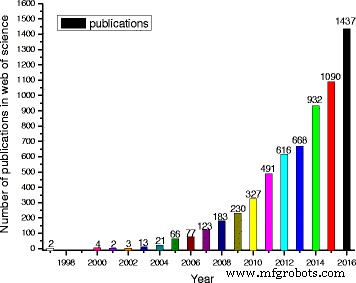
"web of science"에서 검색된 제목에 "nanofluids or nanofluid"가 포함된 출판물 수
위의 표 1의 소개는 특정 측면에 대해 비교적 포괄적이고 상세한 정보를 제공할 수 있기 때문에 나노유체의 일부 전문화된 방향에 대한 검토의 타당성과 의의를 보여준다. TiO2는 가장 널리 사용되는 종류 중 하나입니다. 나노유체는 우수한 물리적 및 화학적 특성으로 인해 과학자들의 큰 관심을 끌었습니다. 먼저 TiO2 인쇄, 화장품, 공기정화 등의 분야에서 널리 사용되며 인체에 무해한 보편적인 안전한 물질입니다. 이 나노유체의 안전성을 고려하여 Taghizadeh-Tabari et al. [63] TiO2를 적용했습니다. – 우유 저온 살균 산업을 위한 판형 열교환기의 물 나노 유체. 둘째, TiO2 탁월한 화학적 안정성, 산, 알칼리 및 대부분의 유기 용액 침식에 대한 내성이 있습니다. 셋째, TiO2 나노 입자는 더 큰 산업 등급으로 생산되어 상대적으로 경제적입니다[64]. 넷째, TiO2 나노 입자는 특히 적절한 분산제를 첨가할 때 극성 및 비극성 기본 유체 모두에서 비교적 우수한 분배성을 갖습니다. Yang et al. [65]는 암모니아-수용액에서 20가지 유형의 나노입자의 분산 안정성을 조사했다. 결과는 아나타제 TiO2 계면활성제가 없는 금속산화물 중 가장 안정한 금속산화물로 적절한 계면활성제를 첨가하면 안정성을 더욱 높일 수 있다. Silambarasan et al.의 보고서[66]에서 TiO2의 흡광도는 나노유체는 그림 2와 같이 10일 보관 후 변화가 거의 없었습니다. 이러한 약간의 흡광도 변화는 TiO2의 안정성을 나타냅니다. 그들이 준비한 나노 유체는 상당히 주목할 만했습니다. 사용 가능한 문헌을 요약하면 TiO2 일반적으로 나노 입자는 다른 기존의 금속 산화물 나노 입자보다 분산성이 우수합니다. 액체에 나노입자의 분산이 나노유체의 적용을 위한 가장 중요한 전제조건이기 때문에 많은 연구자들이 TiO2를 선택했습니다. 연구 주제로 나노 유체.
<그림>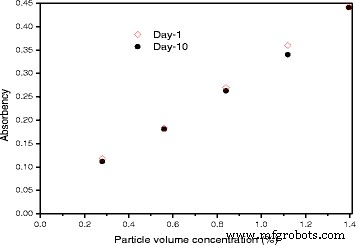
입자 부피 농도의 함수로서의 흡광도 1일차 및 10일차 [66]. Elsevier의 허가를 받아 복제됨
나노유체의 준비는 전제 조건이고 물리적 특성은 에너지 관련 응용 프로그램을 설계하고 구축하는 데 중요한 요소이기 때문에 두 검토의 목적은 TiO2에 대한 최근 연구 진행 상황을 체계적으로 요약하는 것입니다. 준비, 안정성, 물리적 특성 및 에너지 응용을 포함한 나노 유체. TiO2의 준비, 속성 및 적용에 대한 두 가지 검토의 상세한 도식 스케치 나노유체는 그림 3에서 볼 수 있다. 이 리뷰는 실용화에 가장 근접한 종류 중 하나로 여겨지는 특정 종류의 나노유체의 관점에서 구성되었다. 그리고 이 논문의 주요 목표는 연구자들이 TiO2의 연구 현황에 대한 지식을 업데이트하는 데 유용한 참고 가이드를 제공하는 것입니다. 나노유체와 미래 연구 방향에 대한 중요한 과제와 유용한 권장 사항을 지적합니다.
<그림>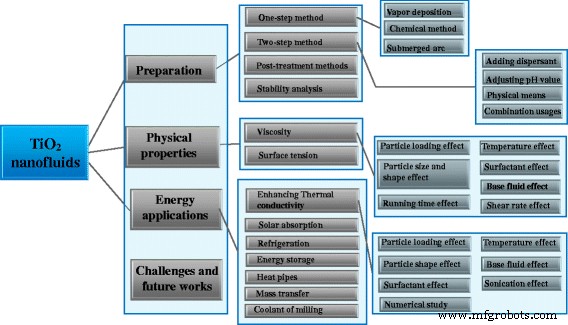
TiO2의 준비, 속성, 적용 및 과제에 대한 도식적 스케치 나노유체
일반적으로 두 가지 주요 준비 방법, 즉 1단계 및 2단계 방법으로 구분할 수 있습니다. 1단계 방법은 나노 입자를 생성 과정에 따라 필요한 작동 유체에 현탁하여 구현됩니다. 원스텝 방법은 다시 물리적 방법과 화학적 방법으로 나눌 수 있습니다. 물리적 방법에는 증착, 레이저 절제 및 서브머지드 아크가 있습니다. 화학적 방법은 화학 반응에 의해 나노 유체를 생성하는 것을 의미합니다. 일반적으로 건조 나노입자의 제조방법으로는 위의 방법들이 도입된다. 그러나 이러한 방법은 건조 입자 수집기를 해당 기본 유체 용기로 교체하여 나노 유체의 1단계 준비 방법으로 업그레이드할 수 있습니다.
증기 증착은 나노유체 제조에 있어 일반적인 물리적 방법입니다. 이 방법에 대한 일반적인 장치는 그림 4[67]에서 볼 수 있습니다. 나노입자 제조를 위한 벌크 고체 물질은 불활성 기체가 채워진 저압 용기에서 가열 및 증발되며, 원료의 증기는 소용돌이치는 액막에 의해 냉각되어 기본 유체에 침강된다. 증착은 일반적으로 금속 나노유체의 제조에 사용되지만 이 방법은 TiO2에는 거의 사용되지 않습니다. 끓는점의 높은 온도 때문에 나노 유체. 그러나 이 방법은 고온을 달성하기 위해 전기 가열을 사용하여 개선할 수 있습니다. Lee et al. [68]은 TiO2를 포함하는 에틸렌 글리콜(EG) 기반 나노 유체를 제조하기 위해 1단계 펄스 와이어 증발(PWE) 방법을 사용했습니다. 나노 입자. 그들은 가는 와이어에 펄스 25kV 전압을 가하고 몇 밀리초 내에 플라즈마로 증발하기 위해 과열했습니다. 그런 다음 플라즈마는 아르곤 산소와 상호 작용하여 나노 입자로 응축됩니다. 마침내 그들은 TiO2를 얻었습니다. 나노입자가 챔버 벽 내부의 EG와 직접 접촉하도록 하여 나노유체.
<그림>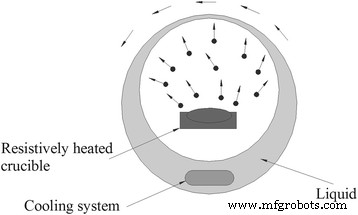
나노유체 제조를 위한 증착법의 대표적인 장치. 참조를 기반으로 다시 그려짐 [67]
서브머지드 아크 방식은 TiO2 준비를 위해 더 높은 온도를 제공하고 유지할 수 있습니다. 나노유체. Chang et al. [69] TiO2를 생산하기 위해 새로운 수중 아크 합성 시스템을 제조했습니다. 나노유체. 그들의 장치는 주로 아크 스프레이 장치, 진공 공간, 온도 및 압력 제어 시스템으로 구성되며 그림 5에 나와 있습니다. 이 장치에서 벌크 TiO2 진공에서 아크방전법으로 고체를 기화시킨 후 기체상태의 TiO2 분리된 액체에 의해 미세한 고체로 빠르게 냉각되었습니다. 그들은 제조된 나노유체가 더 높은 분산 안정성을 가지며 뉴턴 유체로 간주될 수 있기 때문에 이 방법이 에어로졸 방법보다 더 두드러진다고 결론지었습니다. Zhang et al. 반응 변수 제어 시스템, 냉각 순환 및 서브머지드 아크 장치의 크기를 최적화하여 서브머지드 아크 방식을 개선했습니다. 최적화된 시스템을 기반으로 보다 안정적이고 미세한 TiO2를 생산할 수 있습니다. 입자 크기의 재현성이 좋은 현탁액. 그리고 TiO2의 흡착 성능 나노 입자는 상업용 것보다 낫습니다.
<그림>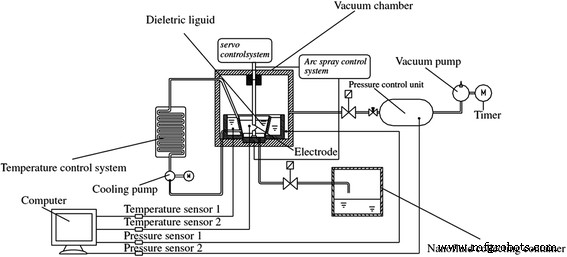
개략도 개선된 수중 아크 나노유체 합성 시스템(ISANSS) [40]. 일본 금속 재료 연구소의 허가를 받아 복제
화학적 방법은 화학 반응에 의해 나노유체를 얻는 것으로 일반적으로 공침법과 전구체 전환법이 있다. TiO2 합성의 기존 화학적 방법 나노유체는 전구체 TiO(OH)2를 기반으로 합니다. 타이타닉 무기염과 암모니아-물의 화학 반응에 의해 침전된 다음 TiO2를 얻기 위해 소성됩니다. 가루. 일부 연구에 따르면 화학적 방법으로 얻은 나노유체는 2단계 방법으로 만든 것보다 안정성과 열전도도가 더 높다[71]. 나노 입자의 미세 구조 제어 가능성은 이 방법의 또 다른 구별되는 특징입니다. 기존의 조정 방법은 합성 온도, pH 값, 초음파 수조 시간 및 첨가제와 같은 매개 변수를 제어하는 것입니다[72]. 그러나 이 방법은 주로 TiO2를 준비하는 데 사용됩니다. 이 방법에서 복잡한 액체 환경의 결과로 액체를 건조하여 분말을 만드는 것은 나노 유체의 세부적인 응용에 적합하지 않습니다. 동안 TiO2 분말은 건조 공정 없이 벌크 유체를 변경하여 필요한 기본 유체에 안정적으로 현탁될 수 있으며, 이 방법은 산도 또는 알칼리도 및 전해질 농도와 같은 새로운 액체 환경 매개변수가 준비를 위한 원래 유체에 가까운 조건에서 유망할 것입니다.
원스텝 방식은 나노입자의 덩어리를 형성하기 쉬운 건조 및 분산 공정을 포함하지 않습니다. 따라서 일반적으로 원스텝 방법이 보다 안정적인 나노유체를 얻을 수 있는 것으로 여겨진다[73]. 그러나 1단계 방법의 적용 범위를 제한하는 몇 가지 결함도 있습니다. 예를 들어, 증기 증착은 고비점 또는 비결정 나노입자를 포함하는 나노유체를 제조하는 데 사용할 수 없습니다. 레이저 제거 및 진공 매립 아크 방법은 비용이 많이 들고 중요한 상황 조건이 필요합니다. 화학적 방법은 일반적으로 필요한 pH 값 및 온도와 같은 특정 반응 조건의 서비스를 필요로 합니다. 그리고 액체에서 일부 부산물을 쉽게 합성할 수 있습니다[74]. 예를 들어, Sonawane et al. [75] 아나타제 TiO2를 합성하기 위해 졸-겔 방법을 사용했습니다. 5의 일정한 pH 값을 갖는 나노 입자. 전구체 용액에는 티타늄 이소프로폭사이드 및 이소프로판올과 이중 증류수가 포함되었습니다. 이러한 특정 pH 값과 복잡한 화학 조성을 가진 이 혼합물은 열전달 나노유체로 사용할 수 없다고 결론지을 수 있습니다. 따라서 합성된 TiO2 나노 입자를 초음파 처리하여 물, EG 및 파라핀 오일을 포함한 필요한 기본 작동 유체에 재분산하여 필요한 나노 유체를 얻습니다. 원스텝 방법은 특정 성분을 가진 일부 나노유체, 특히 순수한 물, 오일, 냉매 등을 기본 유체로 하는 나노유체 및 휘발성 가스를 포함하는 응용 시스템에 거의 활용되지 않는다는 결론을 내릴 수 있습니다.
2단계 방법에서는 나노입자를 생성하고 이를 필요한 기본 유체에 현탁시키는 공정이 독립적으로 운영됩니다. 2단계 방법은 TiO2에 널리 사용됩니다. TiO2 합성 기술 이후 나노유체 나노 입자는 본질적으로 산업적 생산 규모에 도달했습니다. 그림 6은 2단계 방법의 일반적인 절차를 보여줍니다. 건조 나노입자는 먼저 화학적 또는 물리적 방법으로 합성된 다음 필요한 기본 유체에 현탁됩니다. 그러나 강한 입자 상호 작용력은 나노 입자의 충돌 및 응집을 유발할 수 있기 때문에 기본 유체에 안정적이고 균일하게 부유하기가 다소 어렵습니다. 따라서 나노유체의 우수한 안정성과 가용성을 보장하기 위해 일반적으로 일부 분산 방법이 사용됩니다.
<사진>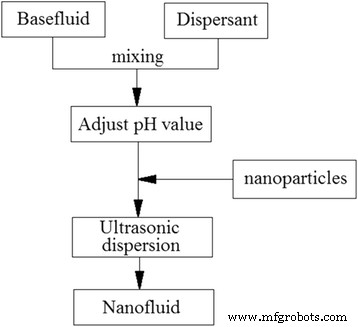
나노유체의 2단계 제조 방법의 전형적인 절차[35]. Elsevier의 허가를 받아 복제됨
표 2는 TiO2의 제조 방법에 대한 관련 연구의 요약을 보여줍니다. 최근 몇 년 동안 나노 유체. 기본 유체의 종류에는 물, EG, 냉매, 유기 용매 등이 포함됨을 알 수 있습니다. 일반적으로 기본 유체에서 나노 입자의 분산 및 현탁을 위한 세 가지 주요 기술이 2단계 준비 과정에서 널리 사용되었습니다.
첫 번째 분산 방법은 분산제를 첨가하여 입자 표면을 개질하는 것으로, 분산제 분자의 정전기적 반발 또는 입체 장애의 역할에 의해 나노 입자가 응집되는 것을 방지할 것으로 기대된다[76]. 기존 보고에서 가장 많이 사용된 계면활성제는 CTAB임을 알 수 있다. 그리고 SDBS, SDS, PVP, 올레산, 아세트산 및 PEG를 포함한 다른 종류도 일부 연구에 사용되었습니다. 2012년에 Mo et al. [77] 막대 모양의 루틸 TiO2를 현탁하여 두 종류의 나노유체를 제조하는 2단계 방법 및 구형 아나타제 TiO2 물에. 그들은 분산제로 SDS를 사용할 때 나노 유체가 286시간 동안 안정적으로 유지될 수 있음을 관찰했습니다. 다음 해에 그들은 SDBS, PVP 및 CTAB를 포함한 세 가지 다른 계면활성제에 의한 분산 효과를 비교했습니다[78]. 그리고 이 실험적 연구 범위에서 SDBS와 이산화티타늄 나노입자의 질량비가 0.3일 때 나노유체의 가장 좋은 분산을 얻을 수 있음을 발견했다. Nakayama와 Hayashi[79]는 TiO2의 높은 부하를 분산시키기 위해 2단계 방법을 사용했습니다. 프로피온산 및 n-헥실아민에 의한 표면 개질의 도움으로 유기 염기 액체의 나노 입자. 그들은 표면 개질이 나노유체의 분산을 향상시킬 수 있음을 발견했으며, 이는 1단계 방법보다 2단계 방법에서 더 나은 효과를 보였다. TiO2의 특성 그들이 준비한 나노 입자는 변하지 않으며 다른 유기 용매 기본 유체에 잘 적용될 수 있습니다.
두 번째 분산 방법은 기본 유체의 pH 값을 조정하여 분산 환경을 조정하는 것입니다. 이 방법은 유체의 적절한 pH 값을 조정하여 나노입자에 더 높은 제타 전위를 제공하는 것으로, 더 높은 정전기 반발에 의한 나노입자의 접촉을 피할 것으로 예상됩니다[76]. Li와 Sun[80]은 TiO2의 응집 거동에 대한 pH 값의 영향을 조사했습니다. SRFA 및 Fe(III)에 의한 단일 및 이원 기본 액체의 나노 입자. 그들은 SRFA의 흡착이 TiO2의 현탁 안정성을 크게 향상시키는 것을 발견했습니다. 4, 6, 8의 pH 값에서 나노 입자를 발견했으며, 이는 주로 입자 표면의 음전하의 급격한 상승으로 인해 발생한다고 생각했습니다. 그는 외. [81] TiO2의 안정성을 발견했습니다. 나노유체는 기본 유체의 pH 값을 11로 조정하여 크게 개선할 수 있으며, 이 값에서 45mV의 높은 제타 전위가 형성되어 재응집 및 침착 및 가능한 후속 오염을 방지할 수 있습니다. 최적의 pH 값을 가진 나노유체는 몇 달 동안 안정적으로 유지될 수 있습니다. 또한 Vakili et al. [82] 및 Sen et al. [83]은 기본 유체의 pH 값을 11로 조정했으며 TiO2 나노유체는 이 강알칼리성 조건에서 더 나은 분산 안정성을 가질 수 있습니다.
세 번째 분산 방법은 기계적 교반, 초음파 및 교반 비드 밀링과 같은 물리적 수단에 의해 입자 덩어리를 파괴하는 것과 같습니다. 이러한 방법은 전단, 파손 및 분산 효과로 이어질 수 있는 캐비테이션 진동을 생성해야 합니다[84]. 나노유체는 적절한 초음속 진동 후에 더 안정될 것이라는 것이 보편적으로 인정되고 증명되었으며, 분산안정성 TiO2의 요약으로 다시 한번 증명될 수 있다. 나노유체. 표 2에서 볼 수 있듯이 거의 모든 준비 과정에는 약간의 물리적 처리가 포함됩니다. Li et al. [85] 분산된 TiO2 TiO2를 준비하기 위해 MDEA 용액에 나노입자 –MEDA–H2 오 나노유체. 그들은 나노 유체가 분산제를 추가하지 않고 기계적 교반으로 48시간 동안 안정적으로 유지할 수 있음을 발견했습니다. Tajik et al. [86] 수성 TiO2의 부유 거동에 대한 다양한 초음파 유형(연속 또는 불연속 펄스)의 영향을 조사했습니다. 나노유체. 결과는 연속 펄스가 불연속 펄스보다 더 나은 차단 효과를 갖는 반면 후자는 일부 큰 응집체를 분리할 수 없음을 보여주었습니다. 실람바라산 et al. [66] 서브미크론 TiO2를 포함하는 수성 혼합물의 현탁 거동에 대한 교반 비드 밀링 및 초음파 처리의 효과를 실험적으로 조사했습니다. 입자. 그들은 교반 비드 밀링이 서브미크론 입자를 포함하는 안정적인 현탁액을 생성할 수 있고 TiO2의 수송 거동을 제어하기 위해 초음파 처리를 추가로 적용할 수 있음을 발견했습니다. 정학. Longo와 Zilio[87]는 TiO2의 분산 거동에 대한 기계적 교반과 초음파의 효과를 비교했습니다. – 물과 Al2 O3 – 물 나노 유체. 그들은 25kHz에서 48시간 동안 초음파 처리하는 것이 단순한 기계적 교반보다 분산 효율이 더 우수함을 관찰했습니다. 이러한 물리적 분산 처리 후 두 종류의 나노 유체는 1개월 이상 안정 상태를 유지할 수 있습니다.
일반적으로 나노유체의 더 나은 분산 성능을 달성하기 위해 계면활성제 첨가, 베이스 유체의 pH 값 변화, 초음파 진동의 분산 방법의 조합이 2단계 방법으로 활용됩니다. Liu et al. [88] 분산된 TiO2 안정한 TiO2를 준비하기 위한 물 속의 나노입자(25nm) 나노유체. 분산제로 PEG1000 추가, 초음파 진동 및 pH 값을 4–5 또는 9–10으로 조절하는 등 세 가지 처리를 사용하여 안정적인 TiO2를 얻었습니다. 나노유체. Fedele et al. [89] 분산제로서 아세트산을 첨가하고 나노입자의 질량 분율에 따라 pH 값을 1.86 ~ 3.07 범위로 조절하는 조합 분산 방법과 적절한 초음파 처리를 사용하였다. 그들은 입자의 평균 크기가 기간 동안 거의 일정하게 유지되기 때문에 나노 유체가 최소 35일 동안 안정적으로 유지될 수 있음을 관찰했습니다. Ghadimi et al. [90] 매우 안정적인 수성 TiO2 준비 초산을 첨가하고 pH를 5로 조정하고 초음파 진동으로 나노 유체. TiO2를 찾았습니다. 나노유체는 1년 보관 후에도 안정적으로 정지되었습니다. 세 가지 기술을 결합하여 사용하는 다른 예도 있습니다. Mo et al. [77, 78], Kim et al. [91], Mushed et al. [92], Jarahnejad et al. [93], Ghadimi et al. [90], 그리고 Said et al. [94] 최고의 분산 효과를 달성하기 위해 세 가지 분산 기술을 모두 사용했습니다.
그러나 기본 유체의 pH 값을 변경하면 TiO2의 적용 범위가 심각하게 제한됩니다. 산성 및 알칼리성 조건에서 부식 및 안전성으로 인해 열 유체로서의 나노 유체. 따라서 더 많은 연구자들이 다른 두 가지 분산 기술을 사용하는 경향이 있습니다. 실제 시스템에서 잠재적인 응용을 위한 분산제 및 물리적 수단을 추가합니다. Wu et al. [95] 및 Yang et al. [74] TiO2 적용 예정 나노유체를 암모니아 수분 흡수 냉각 시스템으로 전환. 기본 유체는 암모니아 농도에 따라 결정되는 특정 pH 범위가 있기 때문에 pH 값을 변경하는 방법을 사용할 수 없습니다. 따라서 TiO2의 안정성을 향상시키기 위해 초음파 진동과 결합된 분산제로 PAA 또는 PEG1000을 사용했습니다. 나노유체와 좋은 효과를 얻었습니다. 압축 냉동 시스템에 나노유체를 적용하기 위해 Peng et al. [96] TiO2 추가 나노 입자를 R141b에 넣어 입자 크기가 각각 25, 40, 60, 100nm인 나노 냉매를 제조합니다. 나노 냉매를 초음파 처리기를 사용하여 20분 동안 초음파 처리했습니다. 그리고 그들은 이 단계가 벌크 냉매에서 나노 입자의 우수한 분산을 달성하는 데 중요하다고 생각했습니다. 또한 음이온성, 양이온성, 비이온성 계면활성제가 나노 냉매의 안정성에 미치는 영향을 실험적으로 연구하였다. 그리고 그들은 계면 활성제 유형이 정상 상태 입자 크기에 중요한 요소임을 관찰했습니다. Kayhani et al. [97] 계면활성제 헥사메틸디실라잔을 사용하고 초음파 진동법으로 건조된 TiO2 제조 먼저 나노 입자를 증류수에 첨가하고 초음파 진동(400W 및 24kHz) 처리로 3~5시간 동안 처리합니다. 그들은 준비된 나노 유체가 며칠 동안 안정적으로 유지되고 침전이 일어나지 않는다는 것을 발견했습니다. Yang et al. [98]은 저농도 범위의 계면활성제 SDBS와 초음파 진동의 사용이 암모니아-수계 TiO2의 현탁 거동을 향상시킬 수 있음을 발견했습니다. 나노유체.
기존의 1단계 또는 2단계 방법 외에도 나노유체 제조를 위한 일부 후처리 방법도 제안되었습니다. 일부 특수 처리를 통해 덩어리진 나노입자를 포함하는 제대로 분산되지 않은 원시 유체에서 더 잘 분산된 나노유체를 얻을 수 있습니다.
Hwang et al. [99]는 교반기, 초음파 수조 및 초음파 교란기의 효과가 나노 유체의 분산을 향상시키는 데 제한적임을 관찰했습니다. 그들은 고압 균질기를 사용하여 나노유체를 후퇴시켰고 그 과정은 그림 7에서 볼 수 있습니다. 그들의 연구에서 입자의 초기 평균 직경은 고압 균질화기. 그리고 그들은 고압 균질화가 그들의 연구에 사용된 모든 물리적 분산 수단 중에서 가장 좋은 효과를 나타냄을 발견했습니다.
<그림>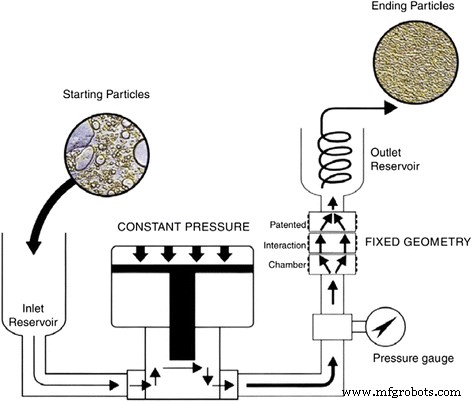
나노유체 제조용 고압 균질기의 개략도 [99]. Elsevier의 허가를 받아 복제됨
Yang et al. [100] 나노유체를 제조하기 위해 최적화 방법을 사용했다. 나노유체의 분산 개선을 위한 최적화 과정을 Fig. 8에 나타내었다. 그들은 벌크 고농축 나노유체에서 잘 현탁된 나노유체를 제거한 후, 기본유체를 희석하여 제거된 부분을 원하는 농도로 회복시켰다. 희석비는 나노유체의 흡광도가 농도에 정비례하는 성질을 기준으로 하였다. 그리고 침강을 관찰하고 흡광도의 변화를 측정하여 방법의 효과를 추정했습니다. 결과는 금홍석과 아나타제 TiO2 모두에 대해 나노 유체, 최적화된 방법은 분산을 크게 개선하고 보다 안정적인 TiO2를 생성할 수 있습니다. 나노유체.
<그림>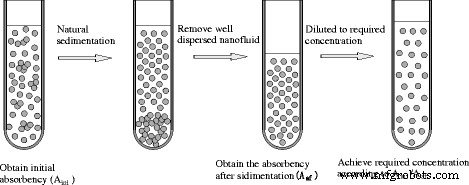
나노유체의 분산 개선을 위한 최적화 과정[132]. Taylor &Francis의 허가를 받아 복제
나노유체의 제조에 대한 논쟁에는 몇 가지 논쟁이나 불일치가 있다. 첫째, 1단계 방법을 채택할 것인지 2단계 방법을 채택할 것인지가 불일치합니다. 원스텝 방식은 나노입자의 건조 및 분산 과정을 피할 수 있어 더 나은 분산 안정성을 얻을 수 있을 것으로 기대된다. 그러나 부산물과 같은 1단계 방법의 부작용으로 인해 나노유체의 적용 범위를 심각하게 제한하는 특수 용액 환경이 더 치명적으로 보입니다. 따라서 TiO2의 분산 기술의 상당한 개선과 뛰어난 적응성으로 인해 2단계 방법이 더 널리 사용됩니다. 나노 입자. 전반적으로 TiO2의 준비를 위해 적절한 후처리와 함께 2단계 방법을 사용하는 것이 좋습니다. nanofluids.
Another controversy is whether surfactant should be used in the preparation of nanofluids. The presence of appropriate surfactant can improve the dispersion stability but also may bring some side effects such as a decrease in thermal conductivity, increases in viscosity, and foaming ability. Due to the potential advantages such as reduction in surface tension and improvement in re-dispersible property, the surfactant with low concentration is suggested to be used when it not brings obvious decrease in thermal conductivity or increase in viscosity and foaming ability. In addition, the influence of surfactant on thermal conductivity and viscosity of nanofluids is also a controversy in current studies.
Stability research is generally followed the preparation to achieve the optimal dispersion craft since it is closely related to the effectiveness and practicability of nanofluids. The great amount of aggregations in the unstable nanofluids can easily cause sedimentation and adsorption on the inner surface of the system, which will probably result in the degradation of heat transfer efficiency, raising of pumping power, and even blocking up in system pipe blocks.
It can be found from Table 2 that the stable times of different researchers thought were variously distributed in the range of several hours to 1 year. A most stable nanofluid was obtained by a combined use of adding surfactant, controlling pH value, and ultrasonic vibration by Ghadimi et al. [90]. Also, the particles’ loading in their experiment was very low at 0.1 wt.%, which was also another contribution for the long-term stability. Without adding surfactant, the nanofluids can also achieve a better dispersion stability by adjusting the pH value of the liquid to a suitable value. For example, He et al. [81] and Longo et al. [87] observed that the TiO2 nanofluids can keep stable for months by adjusting the pH to 11 with the help of ultrasonic vibration. Also, some TiO2 nanofluids with good dispersion stability were prepared only through physical means in some research. Padmanabhan et al. [101] used a magnetic stirring to prepare R134a and mineral oil-based TiO2 nanofluids that can keep stable for 6 months. This is likely because the particles’ loading employed in their study is very low (0.1 g/L) and the high viscosity of the R134a and mineral oil base fluid can also provide a superior dispersion condition. This conclusion can also serve as proved by Palabiyik et al.’s results [102]. They obtained a TiO2 nanofluids stable for several months by the help of sonication with a higher viscosity propylene glycol as base fluid. The similarity is that they were both using organic solvent of high viscosity as base fluids and the best ones was only treated by physical means. Also, it can be seen that TiO2 nanoparticles have a comprehensive dispersivity in both polar aqueous solution and nonpolar organic solution.
However, the above judgments on dispersion stability of various TiO2 nanofluids are not very objective and accurate because most of the results showed the least stable time. Moreover, there is no uniform standard for evaluating the stability of nanofluids, and the stability evaluating methods in different research were sufficiently different. Current evaluation methods of stability of nanofluids mostly consisted of observing the stratification or sedimentation and testing the zeta potential, particles’ size, or absorbency. Mansel et al. [103] used the sedimentation observation method and zeta potential method to evaluate the stability of TiO2 –water nanofluids in different pH values. They observed that in low or high pH value, the TiO2 –water nanofluids can obtain good stability. Mo et al. [78] used zeta potential method to investigate the stability of TiO2 –water nanofluids with three different surfactants SDBS, PVP, and CTAB, respectively. By comparing the value of zeta potential, they obtained the optimal kind of surfactant and the best dispersion of nanofluid. Wei et al. [104] used sedimentation, zeta potential (ζ), and size analysis to evaluate the stability of diathermic oil-based TiO2 nanofluids. They found that there was not obvious sedimentation and the zeta potential (ζ) and size analysis also showed good results. They thought the TiO2 nanofluids they prepared were very stable and can be used to enhance heat transfer for a fluid system. Li et al. [105] used sedimentation observation to investigate the stability of TiO2 –MDEA–water nanofluids. They found that after a specific period of mechanical agitation, the sedimentation was reduced and the stability of nanofluids was improved. However, the ultrasonic vibration will deteriorate the stability of TiO2 –MDEA–water nanofluids. For this reason, only mechanical agitation was employed in their research. Yang et al. [74] investigated the dispersion behavior of 20 types of nanoparticles in binary base fluid of ammonia–water by measuring the absorbency of nanofluids, and they defined ratio of varying absorbency to quantitatively compare the suspending stability of different kinds of nanoparticles, dispersant, and base fluid mixtures. They observed that the new defined index was more applicable than conventional means because it could directly compare the suspending behavior of various kinds of nanofluids. While the method of observing the stratification or sedimentation is restricted for nanofluids in different colors or without distinctly stratification after standing. The results showed that the anatase and rutile TiO2 nanofluid were the most stable metal oxides without any surfactant. And when adding optimal dispersant, anatase TiO2 nanofluid was still the most stable one.
Generally, the combination of several stability evaluating methods is employed to investigate the stability of nanofluids more accurately. Silambarasan et al. [66] used method of measuring the particle size distribution, zeta potential, and microscopy of grain size methods to characterize the suspending stability of TiO2 nanofluids. By those methods, they prepared remarkably stable TiO2 nanofluids whose absorbency changed very little after 10 days. Tajik et al. [86] used sedimentation observation and microscopy of grain size to investigate the roles of ultrasonic wave types on the suspending behavior of nanofluids. And they found that the pulses in discontinues type could not smash some big clusters or aggregations since the sedimentation occurred after 48 h of storage.
The physical properties of TiO2 nanofluids are focused on the viscosity and thermal conductivity. Also, a few papers investigated the surface tension. Using nanofluids to enhance the thermal conductivity is a typical application in heat transfer filed. Therefore, the thermal conductivity of TiO2 nanofluids will be introduced in part 2 of the reviews. In part 1, the viscosity and surface tension are introduced as follows.
Viscosity is an essential parameter for nanofluids especially for flow and heat transfer applications because both the pressure drop and the resulting pumping power are depended on the viscosity. Viscosity describes the internal resistance of a fluid to flow, and it is an important property for all thermal and flow applications for nanofluids. The nanofluids with higher viscosity will result in higher flow resistance and lower flow velocity, which also induce the decrease of the heat transfer. To obtain flow velocity and heat transfer efficiency, more pumping powers are needed which induce more energy consumption. Moreover, for some mass transfer application of nanofluids, viscosity plays more important roles than thermal conductivity because the viscosity determines the mass transfer resistance of molecules entering the liquid surface and the diffusion coefficient in the liquid. Murshed and Estellé [106] provide a state-of-the-art review on the viscosity of various nanofluids. They found that the experimental data from various literatures are greatly scattered and not consistent even for the same nanofluids. This review will discuss in detail the influence factors on the viscosity of TiO2 nanofluids to provide an exhaustive knowledge on this topic.
Many literatures have concerned the volume concentration effect on the viscosity of TiO2 nanofluids. Table 3 shows the particle loading dependence of the viscosity of TiO2 nanofluids in different research. It can be observed that the viscosity of the TiO2 nanofluids increases with the increase of the particle loading. However, some works showed that the viscosity ratio varies linearly with variation of volume concentration, but some other results showed the viscosity ratio variation is parabolic. The viscosity enhancements of TiO2 nanofluids were greatly distinguishing in various researches. For example, in Vakili et al. [82], Arulprakasajothi et al. [107], Duangthongsuk and Wongwises [108], Saleh et al. [109], and Mahbubul et al.’s [110] results, the increments of viscosity were below ten times of the volume percentage of the added particles. However, He et al. [111] and Turgut et al.’s [112] results showed that the viscosities were increased by more than 100 times of the volume percentage of the TiO2 particles added. There are also many results distributed between the values in the above two extreme cases. Therefore, it can be concluded that the influence of particle loading on the viscosity of TiO2 nanofluids is more complex than that on thermal conductivity due to the widespread data in various studies.
Besides the volume concentration effect, the temperature effect on the viscosity of TiO2 nanofluids is also widely studied by many researchers. He et al. [111] prepared four different concentration TiO2 –H2 O nanofluids with 20 nm TiO2 and measured the viscosities of TiO2 –H2 O nanofluids and deionized water with different temperatures. They observed that the TiO2 –H2 O nanofluids were Newtonian fluids, which were the same as Chang and Liu’s finding [69], and the viscosities varied inversely with the temperature of the TiO2 –H2 O mixture system. Ling et al. [113] also measured the viscosities of the TiO2 –H2 O nanofluids with different mass fractions, when temperature varied from 15 to 40 °C. They found that the viscosity of the nanofluids increased when fluids thicken and decreased with the increment of the temperature exponentially. Liu et al. [114] figured that the viscosities of TiO2 –H2 O nanofluids increase remarkably with the volume fraction of nanoparticles and vary oppositely to the temperature of the TiO2 –H2 O nanofluids greatly with similar experimental method. Based on the value of the viscosities, they also propose an amended suspension viscosity formula. Some research results showed that the viscosity of nanofluids is a function of volume loading and temperature as well as base fluid viscosity. Yiamsawas et al. [115] measured the viscosity of TiO2 –water with a volume loading varied from 1 to 8% at a high-temperature range of 15 to 60 °C. By comparisons with previous studies, they proposed a useful correlation for practical applications which indicated that the viscosity of nanofluids is a function of volume loading and temperature as well as the base fluid’s viscosity.
Comparing with the absolute viscosity, the varieties of relative viscosity at different temperatures were more impressive for researchers. Jarahnejad et al. [93] carried out a detailed study on the effect of temperature on the viscosity and the relative viscosity of TiO2 respectively. And the results are shown in Fig. 9. It can be found that compared to base water, the average viscosities of TiO2 nanofluids increased by 17, 50, and 78% for 3, 6, and 9 wt.% of particles’ loading, respectively, at 20 °C. The viscosity of nanofluids with different particle loading decreased as the temperature increased, while the relative viscosity remained nearly constant with the temperature. The observation of independent of temperature can be also included in some other research. Fedele et al. [89] presented the characterization of water-based nanofluids where TiO2 ranging between 1 and 35% in mass. They concluded that the relative viscosity was independent from temperature for all the particle loading employed. And the nanofluids at 1 wt.% exhibited a water-like behavior within the experimental error. But this observation was invalid at the higher concentrations (+243% for 35 wt.% at 343 K). Also, Silambarasan et al. [66] found that the temperature has a smaller effect on the relative viscosity since the viscosity of TiO2 suspensions was reproducible even after repeated and alternating heating and cooling processes. And they attributed the reason to the effect of particles’ temperature-dependent intermolecular forces in the suspension. However, some different results can also be observed. Teng et al. [116] found that the relative viscosity increased from 8.2 to 16% when the temperature varied from 10 to 40 °C for the TiO2 nanofluids with 0.5 wt.% of particle loading. Cieśliński et al. [117] found that the relative viscosity of thermal oil-based TiO2 nanofluids remained constant when the temperature varied from 20 to 40 °C, but had a nearly linear increase with the increase of temperature when exceeding 40 °C. Yapici et al. [118] observed that the effect temperature was different for different shear rate. The relative viscosity measured was independent of the temperature at a higher shear rate region. However, for lower shear rate region, a great temperature dependency behavior of viscosity of TiO2 nanofluids was exhibited especially at high temperatures
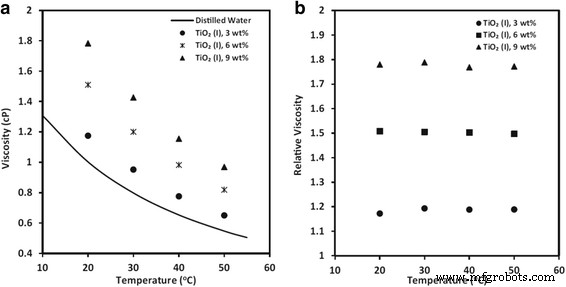
Dynamic viscosity (a ) and relative viscosity (b ) for TiO2 water-based nanofluids at different temperatures [93]. Reproduced with permission from Springer
The particle size and shape effects on the viscosity of TiO2 nanofluids were not investigated as widely as that of particles’ loading or temperature. In particular, Chen et al. [64, 119] investigated experimentally the viscosity of spherical (25 nm) and rod-like (10 × 100) TiO2 nanoparticle-based nanofluids with water and EG as base fluid, respectively. They found that the viscosity of TiO2 nanofluids was more sensitive to the rod-like particles than spherical particles. It can be seen from Table 3 that the viscosity was increased by 0.5–23% when adding 0.1–1.86 vol.% of spherical TiO2 nanoparticles, while increased by 1–82% when adding 0.1–0.6 vol.% of rod-like TiO2 nanoparticles. The same observation can also be found for EG-based nanofluids.
The surfactants have been observed to have great effects on the viscosity of TiO2 nanofluids in some recent research. Jarahnejad et al. [93] investigated the effect of two kinds of surfactant trioxadecane acid and poly carboxylate on the viscosity of TiO2 nanofluids respectively. Their results of the dynamic viscosity of 9 wt.% TiO2 –water nanofluids with different surfactants vs. temperature are shown in Fig. 10. The results demonstrated only a very slight increase was found in the viscosity of nanofluids even with the highest particle loading viz. 9 wt.%. However, the two kinds of surfactants could greatly increase the viscosity of nanofluids in the temperature range of 20–50 °C, especially for trioxadecane acid. The similar effect of surfactant on viscosity can also be observed in Ghadimi and Metselaar’s report [90], in which they found SDS can also increase the viscosity of TiO2 nanofluids with 0.1 wt.% particle loading. It was also observed there were important roles of SDS in the long-term dispersion stability of TiO2 nanofluids. Therefore, they still suggested that the dispersion method of adding surfactant and ultrasonic vibration to be adopted in the preparation of nanofluids.
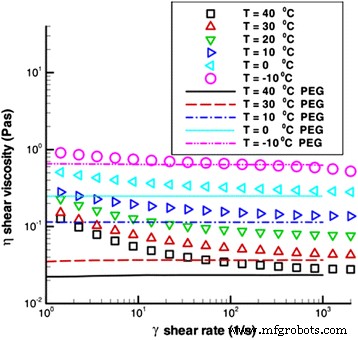
Dynamic viscosity of 9 wt.% TiO2 –water nanofluids with different surfactants vs. temperature [93]. Reproduced with permission from Springer
However, the above results cannot prove that all kinds of surfactant will result in high viscosity for nanofluids. Figure 11 shows the viscosity of TiO2 nanofluids with PEG600 as surfactant measured by Bobbo et al. [120]. It can be seen that the viscosity of base water will not increase but decrease slightly when adding PEG600 at 0.02 or 0.2% loadings. Also, the viscosity of nanofluid containing 0.01% TiO2 nanoparticles and 0.02% PEG600 was a little lower than that of the base water. However, for higher loading of PEG, the viscosity will be greatly increased whether or not containing nanoparticles. It can be seen from Fig. 11 that the nanofluids containing 2% PEG600 and 1% TiO2 nanoparticles showed a viscosity higher than 7% in respect to water, which was analogous at each temperature. The above observation showed the viscosity of nanofluids can be lower than the base fluid in some cases, which also occurred in SWCNT nanofluids in their experiment. The decline of viscosity of fluid when adding surfactant or nanoparticles was also been found in some other research. Yang et al. [121] found that emulsifier OP-10 can reduce the viscosity of ammonia–water in lower concentrations. Ling et al. [122] observed that adding SDBS or OP-10 in TiO2 nanofluids with a lower loading can induce a slight drop in viscosity. Therefore, it is an important issue to choose the suitable surfactants to improve the dispersion stability without increasing the viscosity significantly.
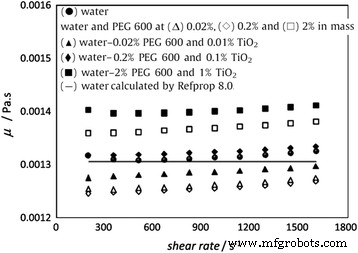
The viscosity of TiO2 nanofluids with PEG600 as surfactant [120]. Reproduced with permission from Elsevier
The information about base fluid effect on viscosity can be illuminated though Chen et al.’s study [119], in which they found the relative increments of viscosity of water-based TiO2 nanofluids were distinctly higher than that of EG based. It seemed that the higher viscosity the base fluid could result in lower increment in viscosity. Mahbubul et al. [110] found that the viscosity of R123 was increased by only 5.2% when adding 2 vol.% TiO2 nanoparticles. Sen et al. [78] and Yapici et al. [118] found relative increments of viscosity about 20 times of the particles’ volume percentages. It also seems that TiO2 nanoparticles are more suitable in the organic liquid because a lower relative increment in viscosity can be obtained especially at the higher temperature. Yiamsawas et al. [123] conducted experiments on a mixture with TiO2 nanoparticles and EG/water (20/80 wt.%) in which the volume loading ranged from 0 to 4% and temperature ranged from 15 and 60 °C. They used the experimental data to present a useful correlation to predict the viscosity.
Another main distinction on the viscosity of TiO2 nanofluids in different research is that whether the fluids were Newtonian fluids in different shear rates. A typical Newtonian nanofluid can be found in foregoing Fig. 11. However, it can be observed from Table 3 that more than half of the results showed that the TiO2 nanofluids in their work are Newtonian fluids, but some others come to the opposite conclusion. Research on rheological characteristic has demonstrated that whether or not the TiO2 nanofluids exhibit Newtonian behavior is also affected by other factors, including the base fluid type, temperature, and particle loading. A quintessential example can be found in Chen et al.’s research [64], where they measured the viscosity of four types of nanofluids made of TiO2 nanoparticles (25 nm) and TiO2 nanotubes (10 nm × 100 nm) dispersed in water and EG. They found that EG–TiO2 nanofluids exhibited Newtonian behavior, whereas water–TiO2 , water–TNT, and EG–TNT nanofluids exhibited non-Newtonian behavior. They indicated that the rheology behavior of TiO2 nanofluids is affected by their specific ingredient and environment, such as particles’ shape and liquid circumstance. The rheological characteristic of TiO2 nanofluids is also related to the temperature. Yapici et al. [118] investigated the rheological characteristic of 9 wt.% TiO2 –water nanofluids with different surfactants vs. temperature. The results are shown in Fig. 12. It can be observed that the base fluid PEG was a typical Newtonian fluid in all kinds of temperature. However, TiO2 –PEG200 nanofluids were nearly Newtonian fluid at a lower temperature and higher shear rate, but it changed into non-Newtonian fluid at higher temperature and lower shear rates. Also, in Said et al.’s results [94], the TiO2 nanofluid with 0.1 vol.% loading was Newtonian fluid at 55 °C, whereas it was non-Newtonian below this temperature for 0.3 vol.% particle loading.

Shear rate dependency of viscosity as a function of temperature for 5 wt.% TiO2 –PEG200 nanofluids [118]. Reproduced with permission from Springer
When the nanofluids are actually used in a running system, the time-dependent properties of nanofluids should be a crucial issue for the sustainable application. However, this matter has not been widely studied because of the faultiness in the development of nanofluids. It is generally considered that the thermal and rheological properties of nanofluids will be deteriorated due to the aggregation of nanoparticles after running a long time in the system. However, an opposite result in the time-dependent viscosity of TiO2 nanofluids can be observed in Said et al.’s research [94]. Their results for viscosity of TiO2 –water nanofluid with different volume loading and temperature as well as running time are shown in Fig. 13. It can be observed that the viscosity of fresh samples and the stale samples after running in a flat plate solar collector for 1 month were distinctly different. The viscosity of TiO2 nanofluids was decreased after undergoing the alternative variations in temperature and flow rate in the cycle. This observation was quite interesting and could not be explained anywhere else in the literature. They thought this finding could open new research scope for the applications of nanofluids for a long-term use.
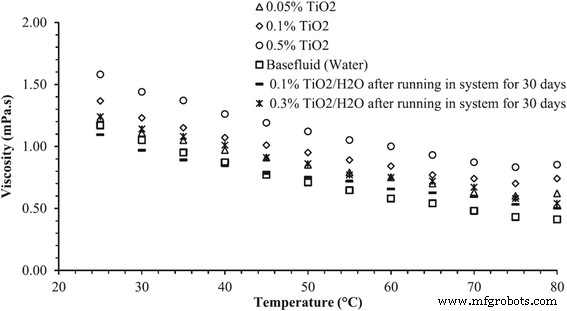
Viscosity of TiO2 –water nanofluid with different volume concentrations and different temperatures [94]. Reproduced with permission from Elsevier
An inconsistency in viscosity of TiO2 nanofluids is quite evident. The intensities of growth in viscosity of TiO2 nanofluids with particle loadings greatly differ in various studies. And there is not yet a universal agreement on the effect of temperature, base fluid, and surfactant on viscosity of TiO2 nanofluids. Moreover, the biggest controversy on viscosity of nanofluid is that whether nanofluid is Newtonian fluid or not. The results in Table 3 exhibit that a substantial part of TiO2 nanofluids in their work are Newtonian fluids, but also, some others exhibit non-Newtonian behavior. The pronounced differences in different samples are mainly due to the complex influence factors on the rheological property. The shear rate has been proved to have great effect on the rheological property, and also, it has combined effect with other factors including temperature, shearing time, particle loading, base fluid type, and particle shape [124], which make it rather difficult to predict whether a nanofluid is Newtonian fluid or not except by experimental means.
The research on surface tension of TiO2 –H2 O nanofluids is much less than that of thermal conductivity or viscosity. Some results showed that adding TiO2 nanoparticles had little effect on the surface tension of nanofluids. Liu et al. [125] prepared TiO2 –H2 O nanofluids whose particle size ranged from 11 to 50 nm and the surface tensions TiO2 –H2 O nanofluids were investigated experimentally. They found the surface tension had no obvious change with the increase in particle loading because the surface tension of nanofluids (1% mass fraction) increased only 1.6% compared with deionized water. Hu et al. [126] found the surface tension of TiO2 –H2 O nanofluids increases slightly when adding nanoparticles. And the surface tension decreased as an increase in temperature. Buschmann and Franzke [127] found that no obvious variation occurs when adding a high-volume fraction (5 vol.%) of TiO2 nanoparticles in water. Tian and Wang [128] measured the surface tension of TiO2 –water nanofluids by Jolly balance and abruption method. They found that the surface tension behavior of TiO2 –water nanofluid was the same as water viz. the surface tension decreased as the temperature increases. However, the variation of surface tension is related to the content of nanoparticles. When the content of nanoparticles increases rapidly, the decrease rate of surface tension of TiO2 –water nanofluids will slow down. Yang et al. [129] observed that nanoparticles have little effect but the surfactant can greatly change the surface tension of nanofluids, when the loading of surfactant is below the critical micelle concentration (CMC). And they explained this appearance as follows:The effect of surfactant on the surface tension of liquid is much greater than that of nanoparticles. When adding nanoparticles into a fluid containing surfactant whose loading is below CMC, the “free” surfactant will be absorbed on the surface of nanoparticles and then immersed in the liquid, which can weaken the reducing effect of surfactant on the surface tension of liquids.
However, some results also revealed that the nanoparticles played an indispensable role in the surface tension of nanofluids. Chinnam et al. [130] measured the surface tensions of Al2 O3 , ZnO, TiO2 , and SiO2 nanofluids with a mixture of 60% propylene glycol and 40% water as base fluids, respectively. They only used one average particle size of 15 nm for TiO2 nanofluid due to limiting of manufacturer. They presented a single correlation as a function of volume loading and particle size as well as temperature for all the nanofluids by statistical analysis based on the experimental results. The experimental and fitting results related to TiO2 nanofluids are shown in Fig. 14. It was observed that the surface tension of nanofluids decreased as the temperature and particle volume loading increase and the correlation perfectly fitted the experimental data. In addition, they also observed that the surface tension decreased as the particle size decrease for a certain loading and temperature of nanofluids except the ZnO nanofluid.
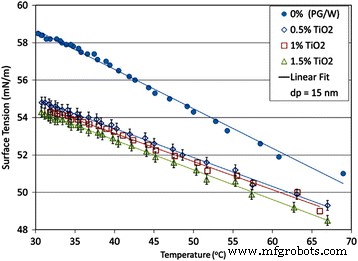
Variation of measured surface tension values of the TiO2 nanofluids with temperature [130]. For different volumetric concentrations up to 1.5% and containing 15 nm particles. Reproduced with permission from Elsevier
Although the surface tension study of nanofluid is not as prevalent as studies in thermal conductivity or viscosity, surface tension is also an important parameter which can affect the film flow especially the initial infiltration of film and the probability of forming channel flow. Due to the effect of surfactant on surface tension of nanofluids is greater than nanoparticles, some researchers thought that the reduction in surface tension by surfactant SDBS can produce a superior enhancement of pool boiling performance in R141b-based nano-refrigerant [131].
The first part of the review focuses on the preparation and two properties viz. viscosity and surface tension of TiO2 nanofluids. It can be concluded that although one-step method is expected to achieve better dispersion stability, the side effects of the one-step method such as producing by-product and requiring special solution environment seem more fatal because they severely restrict the application scope of nanofluids. Suitable treatments such as adding dispersant, adjusting pH values, and physical means (stirring and sonication) used singly or in combination can greatly improve the dispersion stability. And the two-step method is recommended to be employed with appropriate post-treatment for the preparation of TiO2 nanofluids.
Particle loading is positively correlated to the viscosity, but the effects of other factors are not unified. The viscosities greatly differ in different researches which make the viscosity models hard to predict the experimental value, and hence, the experimental mean is firstly recommended. The surface tension of TiO2 nanofluids is more sensitive to surfactant than nanoparticles. The surfactant with low concentration is suggested to be used when it not brings obvious increase in viscosity and foaming ability due to the potential advantages such as reduction in surface tension and improvement in re-dispersible property.
나노물질
초록 이 연구에서 자가 촉매 β-FeSi2 노에서 원했지만 거의 달성되지 않은 나노와이어는 β-FeSi2의 제조가 이루어지는 화학 기상 증착 방법을 통해 합성되었습니다. 단일 소스 전구체인 무수 FeCl3의 분해를 통해 Si(100) 기판에서 나노와이어가 발생했습니다. 750–950 °C에서 분말. 우리는 나노와이어의 성장을 제어하고 조사하기 위해 온도, 지속 시간 및 캐리어 가스의 유속을 신중하게 변경했습니다. β-FeSi2의 형태 나노와이어는 주사전자현미경(SEM)으로 관찰하고 구조는 X선 회절(XRD)과 투과전자현미경(TEM
초록 TiO2 광음극 보호에 적합한 매력적인 반도체이지만 가시광선의 약한 흡수와 낮은 양자 수율로 인해 사용이 제한됩니다. 여기에서 새로운 이종 구조 SnIn4 S8 나노시트/TiO2 나노튜브 광양극을 준비하고 그 광음극 보호 성능을 분석하였다. SnIn4 S8 나노시트가 TiO2 표면에 균일하게 증착되었습니다. solvothermal 처리를 통해 나노튜브. SnIn4 S8 / TiO2 합성물은 순수 TiO2에 비해 더 나은 광음극 보호 성능을 나타냄 나노튜브는 가시광선 반응이 좋고 광발생 캐리어 분리 효율이 우수하기 때문입니다.